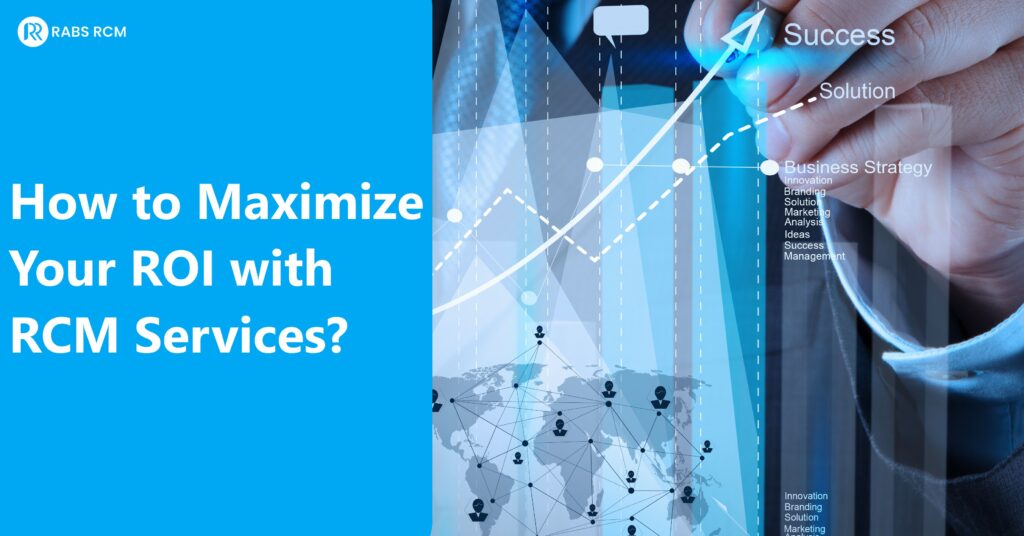Copyright © 2022 Rabs-RCM. All Rights Reserved.

How to Maximize Your ROI with RCM Services?
Return on investment (ROI) in revenue cycle management (RCM) refers to the financial benefits that an organization can expect to receive from investing in initiatives or strategies aimed at improving its revenue cycle processes. Revenue cycle management is the process of managing the financial transactions involved in providing healthcare services, from patient registration to claims submission and payment collection.
Revenue Cycle Management (RCM) services are a crucial component of the healthcare industry, as they help medical facilities optimize their financial performance. However, to maximize your Return on Investment (ROI) with RCM services, you need to understand how they work and what you can do to ensure their success. In this article, we’ll discuss how to maximize your ROI with RCM services.
1. Evaluate Your Current Processes
Before implementing RCM services, it’s important to evaluate your current processes to identify any areas that need improvement. Look for bottlenecks or inefficiencies that are causing delays or errors in your revenue cycle. Once you have identified these areas, you can work with your RCM service provider to develop strategies to improve them.
2. Choose the Right RCM Service Provider
Choosing the right RCM service provider is essential for maximizing your ROI. Look for a provider with experience in the healthcare industry and a track record of success. Consider their pricing model and ensure that it aligns with your budget and financial goals. Additionally, make sure that they offer the services you need, such as coding and billing, claims management, and denial management.
3. Implement Best Practices
Implementing best practices can help you maximize your ROI with RCM services. For example, ensure that your medical coders are highly trained and experienced, as coding errors can lead to claim denials and delays. Additionally, ensure that your billing staff is up-to-date on the latest billing regulations and procedures. By following best practices, you can reduce errors and ensure that claims are processed quickly and accurately.
4. Utilize Technology
Technology can play a crucial role in maximizing your ROI with RCM services. For example, implementing Electronic Health Records (EHRs) can help you reduce administrative costs and improve the accuracy of your medical records. Additionally, utilizing revenue cycle management software can help you streamline your billing and claims management processes. By utilizing technology, you can improve efficiency and accuracy, ultimately leading to a higher ROI.
5. Monitor Key Performance Indicators
Monitoring Key Performance Indicators (KPIs) can help you track your progress and identify areas for improvement. Some important KPIs to track include:
- Days in Accounts Receivable (AR)
- Clean Claims Rate
- Denial Rate
- Net Collection Rate
- First Pass Payment Rate
By monitoring these KPIs, you can identify trends and areas for improvement, ultimately leading to a higher ROI.
6. Continuously Improve
Continuous improvement is essential for maximizing your ROI with RCM services. Regularly evaluate your processes and KPIs to identify areas for improvement. Work with your RCM service provider to develop strategies to address these areas and continuously monitor your progress. By continuously improving, you can optimize your revenue cycle and maximize your ROI.
Conclusion
In conclusion, maximizing your ROI with RCM services requires a strategic approach. By evaluating your current processes, choosing the right RCM service provider, implementing best practices, utilizing technology, monitoring key performance indicators, and continuously improving, you can optimize your revenue cycle and improve your financial performance. Remember, RCM services are an investment in your healthcare facility’s financial future, so it’s important to take the time to implement them correctly and continuously monitor their success.

- Our seamless and streamlined efforts, experience, as well as commitment to our clients, all come together to provide both you and your patients with a remarkable experience to remember.
Contact Us
- 2612 62nd St NW Rochester MN 55901 (USA)
- (507) 262-4566
- info@rabs-rcm.com

